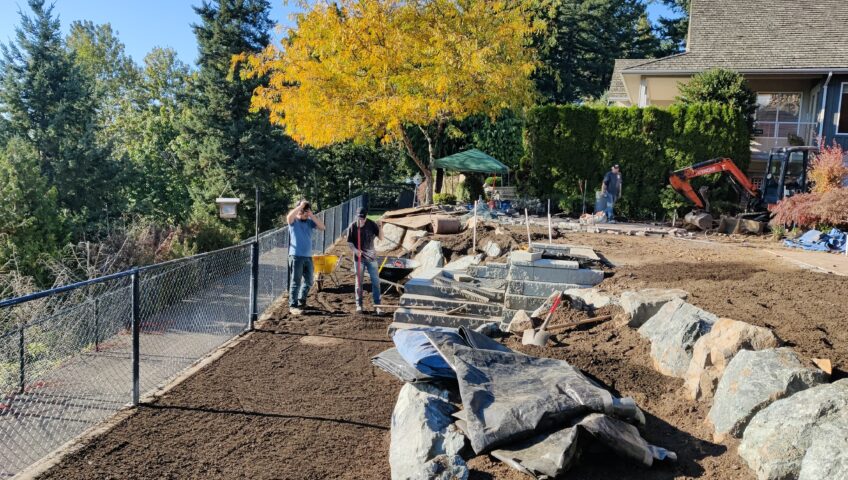The Lower Mainland is in a unique geological position in Canada, granting it diverse climate conditions. Soil conditions and other factors will vary even in small zones, meaning your yard’s condition will likely be unique. But how do you deal with landscaping challenges?
The Lower Mainland’s climate, soil conditions, and geographical position create varied and unique situations. You’ll encounter issues such as invasive species, pests, fungal diseases, and urban soil degradation. Choosing proper landscaping services, solutions, and plant species is crucial to making the perfect yard.
In the guide, we’ll first discuss 4 issues yards commonly face in the Lower Mainland. We’ll then discuss landscaping services that will solve these issues. Read till the end to discover 3 proactive landscaping tips that you should definitely be aware of.
4 Challenges That You’ll Face In The Lower Mainland
Canada’s Lower Mainland is a gardener’s paradise, but it is not a newbie’s playground. Its unique climate, geological positioning, and soil conditions create a host of challenges. Let’s talk about 4 of these challenges that you’ll likely face in your yard, and how to solve them:
Invasive Plant Species
Non-native plant species such as English Ivy (Hedera helix), Himalayan blackberry (Rubus armeniacus), and Japanese knotweed (Reynoutria japonica) invade the yards of the Lower Mainland. The region has mild temperatures and high rainfall, which is the perfect condition for these species to thrive. These grow rapidly and form dense monocultures, outpacing any other species that you may plant.
These plants also cause erosion by displacing deep-rooted native vegetation that is responsible for stabilizing soil. So, if these are in your yard and you have waterlogged or icy soil, expect some serious trouble.
To solve this issue, try the following 3 options:
- Cut Them Off: You can manually remove these species from your yard. Here’s how to remove each of these species:
- English Ivy: Cut the vines at chest height and peel them off from the trees. You should dig out the roots so they cannot grow back.
- Himalayan Blackberry: Wear thick gloves and use loppers to cut off the stems or canes. Dig out the root crowns, or you can smother them with mulch and cardboard.
- Japanese knotweed: The best way to get rid of these is to use a herbicide. You should consult professional landscaping services. They will likely use glyphosate on the stems to kill them.
- Replace With Native Species: You can plant native plant species such as Salal, Sword Fern, or Red-flowering Currant to fill the gaps by these invasive species. As you remove the invasive species, these native ones will outcompete them and take over the land.
- Prevent Growth: You should avoid composting invasive plant species parts. If you see any of them growing on your land, contact the Invasive Species Council of BC.
Harmful Pests And Animals
Some herbivorous animals and bugs will try to munch on your plants. They will leave your plants damaged, and rob them of their opportunity to grow. The most common 3 that you’ll encounter are slugs, snails, and deer.
For slugs and snails, the damp climate of the Lower Mainland is the perfect habitat. They will decimate any hostas, lettuce and seedlings you’ve planted. Try the following 3 solutions:
- Barriers: Surround the beds in your yard with copper tape or diatomaceous earth.
- Traps: You can sink beer-filled containers into the soil of your yard to attract and drown the slugs. You can also lure them into salt or brine.
- Predators: You can use natural predators of these two species to hunt them down. Birds, frogs, and ground beetles will do the trick.
Deer frequent the lands of North Vancouver. They are often seen munching on other people’s gardens. There are 3 ways you can solve this problem:
- Deer-resistant Plants: You can opt for planting Lavender, Foxglove, or Oregon Grape. Deer struggle with them, and will likely abandon any attempts to munch on your plants.
- Fencing: You can have 8-foot fences installed, or opt for angled “deer fencing.” Both will deter deer from jumping into your yard.
- Repellents: You can use egg-based sprays to drive deer away. The sulphur compounds in the spray produce an odour that warns deer of predators nearby. You can also have motion-activated sprinklers installed. These will startle the deer and force them to leave.
Fungal Diseases
Fungus thrives in cold, damp climates. The plants in your yard are always at risk of being infected. The biggest offenders are Phytophthora Root Rot and Powdery Mildew.
Phytophthora Root Rot thrives in waterlogged, muddy soils. These target rhododendrons, azaleas, and cedars. Try these 3 things to get rid of them:
- Install Drainage: Get landscaping services to install raised beds with cedar bark mulch.
- Plant Resistant Species: You can plant Western Red Cedar or Douglas Fir instead of vulnerable species.
- Sterilize Your Tools: You should sterilize your gardening tools with bleach to avoid spreading spores.
Powdery Mildew is a white fungus that coats roses, squash, and lilac during humid summers. Try these 03 solutions:
- Improve Airflow: Space out your plants and always prune dense foliage.
- Use Sprays: Use sulphur sprays, neem oil, or baking soda solutions to kill off the fungus.
- Plant Resistant Species: You can choose to plant fungus-resistant roses like ‘Knock Out’ roses, or cucumbers like ‘Diva.’
Soil Degradation Through Urbanization
Cities like Vancouver and Burnaby have endlessly ongoing construction projects, which lead to pollution and compaction of soil. These issues degrade soil quality, which limits plant growth. You should consider these 4 ideas:
- Soil Testing: Get your yard’s soil tested for heavy metals such as lead or zinc.
- Choose Raised Beds: If the soil condition is too terrible, you can use raised beds and bring in soil from outside.
- Phytoremediation: You can also plant Sunflowers and Mustard Greens. These will absorb the contaminants in your soil.
- Compost Tea: You can spread aerated compost tea on your soil. This will increase microbial activity in your yard, and rejuvenate it.
3 Proactive Landscaping Tips
Here are 3 things you can do to prepare in advance for issues and prevent them from happening:
- Embrace Native Plants: Always choose native species that are suited to your yard’s conditions. Species like Pacific Dogwood and Tall Oregon Grape are adapted to local challenges.
- Monitor Microclimates: Climate conditions wildly vary in different areas. For example, South-facing walls create “heat islands” for tomatoes; north-facing beds suit ferns. You should check your area’s climate conditions and prepare for it.
- Adapt Annually: Try rotating crops, adjusting mulch depth, and revising irrigation based on yearly weather patterns.
It wouldn’t be a wise choice to try and tackle all these issues alone. You’ll need experts with extensive knowledge of the area. And New Wave Earthworks are the landscaping experts you need.
New Wave Earthworks. Landscaping Service Experts.
Armed with over a decade of landscaping experience in the Lower Mainland, New Wave is ready to face all challenges for you and create your perfect yard. We listen to our clients to identify their problems and communicate with them so they can stay on top of things. Our founders are incredibly skilled professionals and they pay attention to every small detail.
If you are looking for landscaping services in the Lower Mainland, especially Chilliwack, Abbotsford, and the Tri-Cities, New Wave Earthworks is your best solution. Call us today at (604) 855-2603!
Conclusion
Just as the Lower Mainland presents challenges, it also presents unique opportunities. It’s a matter of skill, experience, and perspective. Patience and planning are your friends. Remember, don’t start and try to patch things. Plan, consult experts, execute and adapt to create the perfect yard that you dreamed of.


